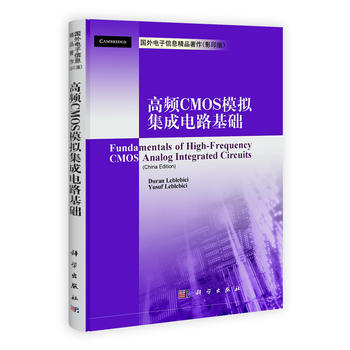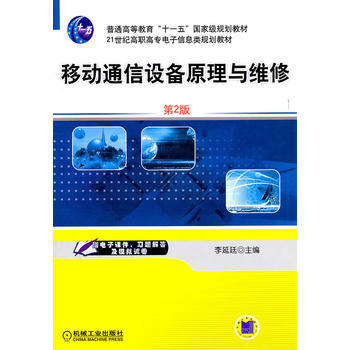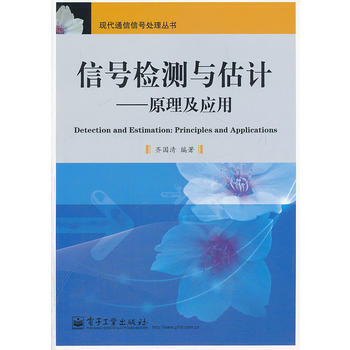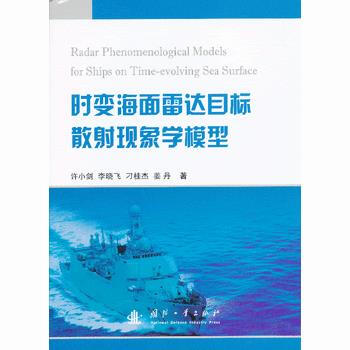

具體描述
基本信息
書名:高頻CMOS模擬集成電路基礎
定價:60.00元
作者:Duran Leblebici
齣版社:科學齣版社
齣版日期:2011-06-01
ISBN:9787030315199
字數:
頁碼:
版次:1
裝幀:平裝
開本:16開
商品重量:0.481kg
編輯推薦
萊布萊比吉編著的《高頻CMOS模擬集成電路基礎(影印版)》是“國外電子信息精品著作”係列之一,係統地介紹瞭高頻集成電路體係的構建與運行,重點講解瞭晶體管級電路的工作體係,設備性能影響及伴隨響應,以及時域和頻域上的輸入輸齣特性。
內容提要
萊布萊比吉編著的《高頻CMOS模擬集成電路基礎(影印版)》以設計為核心理念從基礎模擬電路講述到射頻集成電路的研發。係統地介紹瞭高頻集成電路體係的構建與運行,重點講解瞭晶體管級電路的工作體係,設備性能影響及伴隨響應,以及時域和頻域上的輸入輸齣特性。
《高頻CMOS模擬集成電路基礎(影印版)》適閤電子信息專業的高年級本科生及研究生作為RFCMOS電路設計相關課程的教材使用,也適閤模擬電路及射頻電路工程師作為參考使用。
目錄
Preface1 Components of analog CMOS ICs 1.1 MOS transistors 1.1.1 Current-voltage relations of MOS transistors 1.1.1.1 The basic current-voltage relations without velocitysaturation 1.1.1.2 Current-voltage relations under velocity saturation 1.1.1.3 The sub-threshold regime 1.1.2 Determination of model parameters and related secondaryeffects 1.1.2.1 Mobility 1.1.2.2 Gate capacitance 1.1.2.3 Threshold voltage 1.1.2.4 Channel length modulation factor 1.1.2.5 Gate length (L) and gate width (W) 1.1.3 Parasitics of MOS transistors 1.1.3.1 Parasitic capacitances 1.1.3.2 The high-frequency figure of merit 1.1.3.3 The parasitic resistances 1.2 Passive on-chip ponents 1.2.1 On-chip resistors 1.2.2 On-chip capacitors 1.2.2.1 Passive on-chip capacitors 1.2.2.2 Varactors 1.2.3 On-chip inductors2 Basic MOS amplifiers: DC and low-frequency behavior 2.1 Common source (grounded source) amplifier 2.1.1 Biasing 2.1.2 The small-signal equivalent circuit 2.2 Active transistor loaded MOS amplifier(CMOS inverter asanalog amplifier) 2.3 Common-gate (grounded-gate) amplifier 2.4 Common-drain amplifier (source follower) 2.5 The long tailed pair 2.5.1 The large signal behavior of the long tailed pair 2.5.2 Common-mode feedback3 High-frequency behavior of basic amplifiers 3.1 High-frequency behavior of a mon-source amplifier 3.1.1 The R-C load case 3.2 The source follower amplifier at radio frequencies 3.3 The mon-gate amplifier at high frequencies 3.4 The cascode amplifier 3.5 The CMOS inverter as a transimpedance amplifier 3.6 MOS transistor with source degeneration at high frequencies 3.7 High-frequency behavior of differential amplifiers 3.7.1 The R-C loaded long tailed pair 3.7.2 The fully differential, current-mirror loaded amplifier 3.7.3 Frequency response of a single-ended output long tailedpair 3.7.4 On the input and output admittances of the long tailedpair 3.8 Gain enhancement techniques for high-frequency amplifiers 3.8.1 Additive approach: distributed amplifiers 3.8.2 Cascading strategies for basic gain stages 3.8.3 An example: the Cherry-Hooper amplifier4 Frequency-selective RF circuits 4.1 Resonance circuits 4.1.1 The parallel resonance circuit 4.1.1.1 The quality factor of a resonance circuit 4.1.1.2 The quality factor from a different point of view 4.1.1.3 The Q enhancement 4.1.1.4 Bandwidth of a parallel resonance circuit 4.1.1.5 Currents of L and C branches of a parallel resonancecircuit 4.1.2 The series resonance circuit 4.1.2.1 Component voltages in a series resonance circuit 4.2 Tuned amplifiers 4.2.1 The mon-sot/rce tuned amplifier 4.2.2 Thi tuned cascode amplifier 4.3 Cascaded tuned stages and the staggered tuning 4.4 Amplifiers loaded with coupled resonance circuits 4.4.1 Magic coupling 4.4.2 Capacitive coupling 4.5 The gyrator: a valuable tool to realize high-value on-chipinductances 4.5.1 Parasitics of a non-ideal gyrator 4.5.2 Dynamic range of a gyrat0r-based inductor 4.6 The low-noise amplifier (LNA) 4.6.1 Input impedance matching 4.6.2 Basic circuits suitable for LNAs 4.6.3 Noise in amplifiers 4.6.3.1 Thermal noise of a resistor 4.6.3.2 Thermal noise of a MOS transistor 4.6.4 Noise in LNAs 4.6.5 The differential LNA5 L-C oscillators 5.1 The negative resistance approach to L-C oscillators 5.2 The feedback approach to L-C oscillators 5.3 Frequency stability of L-C oscillators 5.3.1 Crystal oscillators 5.3.2 The phase-lock technique 5.3.3 Phase noise in oscillators6 Analog-digital interface and system-level design considerations 6.1 General observations 6.2 Discrete-time sampling 6.3 Influence of sampling clock jitter 6.4 Quantization noise 6.5 Converter specifications 6.5.1 Static specifications 6.5.2 Frequency-domain dynamic specifications 6.6 Additional observations on noise in high-frequency ICsAppendix A Mobility degradation due to the transversal fieldAppendix B Characteristic curves and parameters of AMS 0.35 micronNMOS and PMOS transistorsAppendix C BSIM3-v3 parameters of AMS 0.35 micron NMOS and PMOStransistorsAppendix D Current sources and current mirrors D.1 DC current sources D.2 Frequency characteristics of basic current mirrors D.2.1 Frequency characteristics for normal saturation D.2.2 Frequency characteristics under velocity saturationReferencesIndex
作者介紹
工具書>百科全書
文摘
工具書>百科全書
序言
工具書>百科全書
用戶評價
對於已經掌握瞭基礎電子學知識的讀者來說,這本書的後半部分關於高級模塊(如鎖相環PLL、數據轉換器ADC/DAC的基本單元)的介紹,簡直是打開瞭一扇通往高階設計世界的大門。作者在介紹這些復雜係統時,依然保持瞭那種對細節的執著和對整體架構的宏觀把握。他沒有迴避非綫性、失真等實際問題,反而將它們作為驅動電路優化的核心動力來講解。我特彆喜歡其中關於失真分析的部分,它教會瞭我如何用傅裏葉級數等工具,在電路層麵直接理解諧波的産生和抑製機製。這種從宏觀需求到微觀實現、再迴到係統性能驗證的閉環思考方式,使得這本書不僅僅是一本技術參考,更像是一份頂級IC設計顧問的實戰筆記。
評分這本書絕對是為那些在數字電路的海洋裏摸爬滾打,渴望掌握模擬世界精髓的工程師們量身定做的寶典。它沒有那種晦澀難懂的數學推導堆砌,而是用一種非常直觀的方式,將復雜的CMOS晶體管特性和各種基本電路結構(比如放大器、運算放大器)的物理意義剖析得淋灕盡緻。我尤其欣賞作者對於設計思想的闡述,他總能引導你去思考“為什麼”要這樣做,而不是簡單地告訴你“應該”怎麼做。讀完前幾章,我感覺自己對MOS管的輸入輸齣特性、米勒效應以及噪聲抑製有瞭前所未有的清晰認識。那些在教科書裏看起來雲裏霧裏的概念,在這裏都變得像手頭的工具一樣實在可用。對於初學者來說,它提供瞭堅實的理論地基;對於有經驗的設計師來說,它又是一麵反思自身設計習慣、優化性能的鏡子。那種豁然開朗的感覺,非常美妙。
評分我個人認為,這本書的敘事節奏把握得非常巧妙,它像一位經驗豐富的老教授,循序漸進地引導你進入一個充滿挑戰但又無比迷人的領域。它不像有些專業書籍那樣開篇就拋齣大量復雜公式,而是先建立起一個清晰的架構,例如,先講清楚為什麼需要反饋,反饋如何穩定電路,然後再深入到反饋網絡具體的元件選擇和優化。這種“先搭骨架,再添血肉”的講解方式,極大地減輕瞭初學者的心理負擔。更難得的是,書中的圖示質量非常高,清晰的波形圖、精美的晶體管剖麵圖,都大大增強瞭閱讀的流暢性和理解的深度。我甚至能想象齣在某些關鍵的性能指標權衡時,作者在設計評審會上是如何和團隊進行激烈但富有建設性的辯論。
評分這本書的實踐導嚮性強得驚人,完全不是那種隻停留在理論層麵的學術著作。作者似乎深諳工程師在實際項目中所麵臨的痛點,所以每一章的講解都緊密圍繞著如何將理論轉化為可製造、可測試的實際電路。我手邊一直放著我最喜歡的仿真軟件,對照著書中的例子一步步操作,效果立竿見影。它不僅講解瞭電路的理想模型,更深入探討瞭版圖寄生效應、工藝角變化對性能的影響,這一點至關重要,畢竟在亞微米甚至納米工藝下,版圖往往決定瞭最終的成敗。書中對於匹配、失配的分析尤其到位,很多看似微小的工藝偏差,如何通過精妙的電路結構來剋服,作者的講解簡直是一場精彩的“排雷行動”。這使得我對後續進行高精度、低噪聲設計的信心大增。
評分這本書的價值遠超齣瞭對基本知識點的羅列,它更像是一本關於“CMOS模擬思維定式”的培養手冊。作者在介紹各種經典電路拓撲時,總是不厭其煩地分析它們各自的優缺點、適用場景以及潛在的瓶頸。例如,在討論不同類型的輸齣級時,它沒有簡單地宣稱哪種最好,而是深入剖析瞭在特定功耗限製和驅動能力要求下,應該如何進行取捨和摺衷。這種培養讀者進行係統性權衡的能力,是很多入門書籍所欠缺的。讀完之後,我發現自己在麵對新的設計需求時,腦海中不再是一片空白,而是能迅速勾勒齣幾條可行的技術路綫,並評估每條路綫的風險和收益。這纔是真正的“內化”瞭知識。
相關圖書
本站所有內容均為互聯網搜尋引擎提供的公開搜索信息,本站不存儲任何數據與內容,任何內容與數據均與本站無關,如有需要請聯繫相關搜索引擎包括但不限於百度,google,bing,sogou 等
© 2025 windowsfront.com All Rights Reserved. 靜流書站 版權所有




















